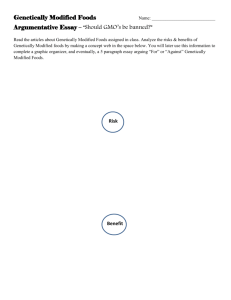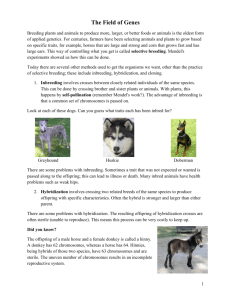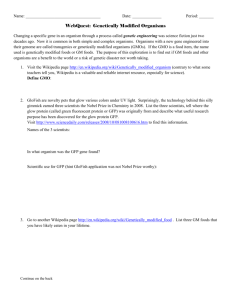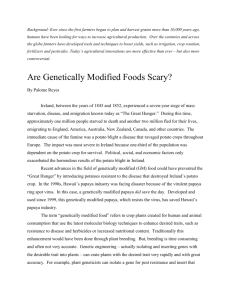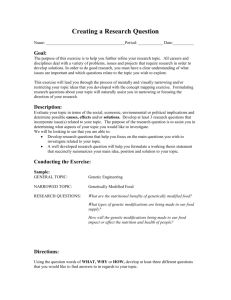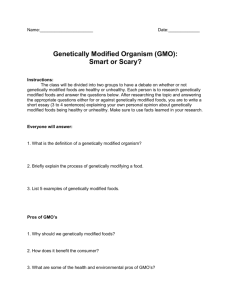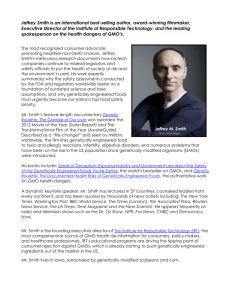Genetically Modified Food
advertisement
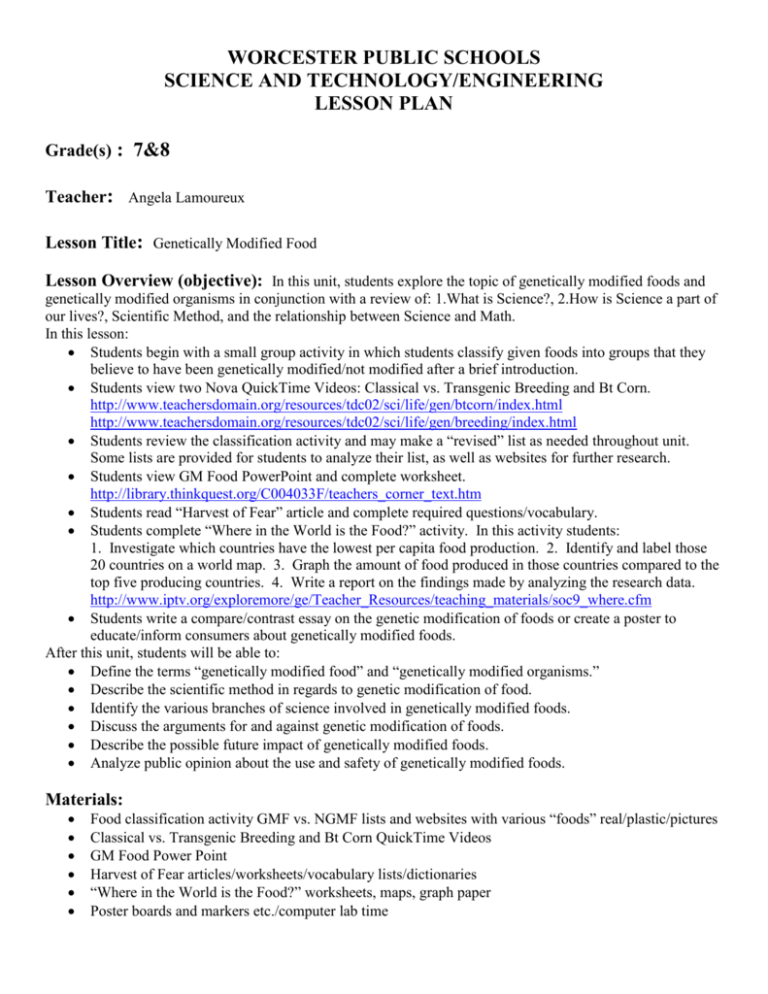
WORCESTER PUBLIC SCHOOLS SCIENCE AND TECHNOLOGY/ENGINEERING LESSON PLAN Grade(s) : 7&8 Teacher: Angela Lamoureux Lesson Title: Genetically Modified Food Lesson Overview (objective): In this unit, students explore the topic of genetically modified foods and genetically modified organisms in conjunction with a review of: 1.What is Science?, 2.How is Science a part of our lives?, Scientific Method, and the relationship between Science and Math. In this lesson: Students begin with a small group activity in which students classify given foods into groups that they believe to have been genetically modified/not modified after a brief introduction. Students view two Nova QuickTime Videos: Classical vs. Transgenic Breeding and Bt Corn. http://www.teachersdomain.org/resources/tdc02/sci/life/gen/btcorn/index.html http://www.teachersdomain.org/resources/tdc02/sci/life/gen/breeding/index.html Students review the classification activity and may make a “revised” list as needed throughout unit. Some lists are provided for students to analyze their list, as well as websites for further research. Students view GM Food PowerPoint and complete worksheet. http://library.thinkquest.org/C004033F/teachers_corner_text.htm Students read “Harvest of Fear” article and complete required questions/vocabulary. Students complete “Where in the World is the Food?” activity. In this activity students: 1. Investigate which countries have the lowest per capita food production. 2. Identify and label those 20 countries on a world map. 3. Graph the amount of food produced in those countries compared to the top five producing countries. 4. Write a report on the findings made by analyzing the research data. http://www.iptv.org/exploremore/ge/Teacher_Resources/teaching_materials/soc9_where.cfm Students write a compare/contrast essay on the genetic modification of foods or create a poster to educate/inform consumers about genetically modified foods. After this unit, students will be able to: Define the terms “genetically modified food” and “genetically modified organisms.” Describe the scientific method in regards to genetic modification of food. Identify the various branches of science involved in genetically modified foods. Discuss the arguments for and against genetic modification of foods. Describe the possible future impact of genetically modified foods. Analyze public opinion about the use and safety of genetically modified foods. Materials: Food classification activity GMF vs. NGMF lists and websites with various “foods” real/plastic/pictures Classical vs. Transgenic Breeding and Bt Corn QuickTime Videos GM Food Power Point Harvest of Fear articles/worksheets/vocabulary lists/dictionaries “Where in the World is the Food?” worksheets, maps, graph paper Poster boards and markers etc./computer lab time Length of Lesson: Four to five 55-minute class periods with homework time will be needed for this unit. Ma. State Frameworks Standard: Recognize that every organism requires a set of instructions that specifies its traits. These instructions are stored in the organism’s chromosomes. Heredity is the passage of these instructions from one generation to another. Recognize that biological evolution accounts for the diversity of species developed through gradual processes over many generations. WPS Benchmarks: 08.SC.IS.01 Formulate a testable hypothesis. 08.SC.IS.02 Design and conduct an experiment specifying variables to be changed, controlled, and measured. 08.SC.IS.03 Select appropriate tools and technology (e.g., calculators, computers, thermometers, meter sticks, balances, graduated cylinders, and microscopes), and make quantitative observations. 08.SC.IS.04 Present and explain data and findings using multiple representations, including tables, graphs, mathematical and physical models, and demonstrations. 08.SC.IS.05 Draw conclusions based on data or evidence presented in tables or graphs, and make inferences based on patterns or trends in the data. 08.SC.IS.06 Communicate procedures and results using appropriate science and technology terminology. 08.SC.IS.07 Offer explanations of procedures, and critique and revise them. 08.SC.IS.08 Use APA Guidelines in writing science reports. 08.SC.IS.09 Apply and understand measurement systems, e.g., English, Metric and Kelvin. 08.SC.IS.10 Use and understand scientific notation. DATA ANALYSIS, STATISTICS, AND PROBABILITY Students will… 08.MA.DA.01 Describe the characteristics and limitations of a data sample. Identify different ways of selecting a sample, e.g., convenience sampling, responses to a survey, random sampling. 08.MA.DA.02 Select, create, interpret, and utilize various tabular and graphical representations of data, e.g., circle graphs, Venn diagrams, scatterplots, stem-and-leaf plots, box plots, histograms, tables, and charts. Differentiate between continuous and discrete data and ways to represent them. 08.MA.DA.03 Find, describe, and interpret appropriate measures of central tendency (mean, median, and mode) and spread (range) that represent a set of data. Use these notions to compare different sets of data. 08.MA.DA.04 Use tree diagrams, tables, organized lists, basic combinatorics (“fundamental counting principle”), and area models to compute probabilities for simple compound events, e.g., multiple coin tosses or rolls of dice. Essential Questions: What are “genetically modified foods” and “genetically modified organisms?” How is the scientific method used in the area of genetically modified foods and organisms? How are the various branches of science involved in genetically modified foods? What are the pros and cons of genetically modified foods? How aware/educated is the public on the topic of genetically modified foods and organisms? Student Outcomes: After this unit, students will be able to: Define the terms “genetically modified food” and “genetically modified organisms.” Describe the scientific method in regards to genetic modification of food. Identify the various branches of science involved in genetically modified foods. Discuss the arguments for and against genetic modification of foods. Describe the possible future impact of genetically modified foods. Analyze public opinion about the use and safety of genetically modified foods. Procedures: The procedures for the unit/lessons are noted in the lesson overview. Information on websites and materials are also listed in the above section. Student Accommodations: (ELL,SPED ect.) Accommodations to include more assistance from the teacher with material presented with mnemonic devices, pictures, verbal cues, etc. Additional time and assistance with modified projects. Assessments: Assessments of withitness during activities Assessment of worksheet/vocabulary/homework/quizzes Assessment of “Where in the World is the Food” project using rubric which will be give to the students at the start of the assignment Assessment of the essay/poster Extensions and Modifications: Modifications will be made according to classes and students needs as noted above in regards to time, ELL, SPED, IEP. Extensions will include instruction and follow up with cluster teachers on assignments. The essays and posters will include instruction/follow up from the cluster English teacher in writing, revision, etc. The “Where in the World is the Food?” activity will include instruction/follow up from the social studies and math teachers. This unit will also be “revisited” in students’ study of genetics to follow.
